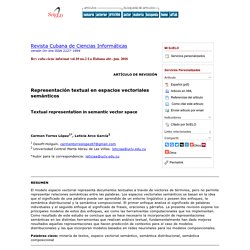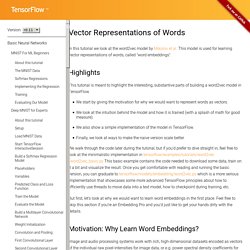

Aplicación de Minería de Datos a Conjuntos de Textos. Como analizar “twitter” de una manera muy sencilla. « Inteligencia en el Negocio. Descifrando el 3.0… Representación textual en espacios vectoriales semánticos. Representación textual en espacios vectoriales semánticos Textual representation in semantic vector space Carmen Torres López1*, Leticia Arco García2 1 Desoft-Holguín. carmentorreslopez87@gmail.com 2 Universidad Central Marta Abreu de Las Villas. leticiaa@uclv.edu.cu *Autor para la correspondencia: leticiaa@uclv.edu.cu El modelo espacio vectorial representa documentos textuales a través de vectores de términos, pero no permite representar relaciones semánticas entre las palabras.

Palabras clave: minería de textos, espacio vectorial semántico, semántica distribucional, semántica composicional The vector space model represents textual documents via vectors of terms, but it cannot represent semantic relationships between words. Key words: text mining, semantic vector space, distributional semantics, compositional semantics En la actualidad es inmensa la cantidad de datos generados por los usuarios en los medios computacionales.
Espacios vectoriales semánticos. MedidasdeDistancia. Vector Representations of Words. In this tutorial we look at the word2vec model by Mikolov et al.

This model is used for learning vector representations of words, called "word embeddings". Highlights This tutorial is meant to highlight the interesting, substantive parts of building a word2vec model in TensorFlow. We start by giving the motivation for why we would want to represent words as vectors.We look at the intuition behind the model and how it is trained (with a splash of math for good measure).We also show a simple implementation of the model in TensorFlow.Finally, we look at ways to make the naive version scale better. We walk through the code later during the tutorial, but if you'd prefer to dive straight in, feel free to look at the minimalistic implementation in tensorflow/examples/tutorials/word2vec/word2vec_basic.py This basic example contains the code needed to download some data, train on it a bit and visualize the result.
Motivation: Why Learn Word Embeddings? Scaling up with Noise-Contrastive Training. How To Use Color To Prove Your Point, From A Data Viz Expert. When working with large amounts of data, precision is key.

The same is true of the art of data visualization: size, shape, shade, hue–the tiniest details of a visualization can radically alter how information is perceived and understood. Which is why color is an important aspect to consider (read: obsess over) when it comes to information design. “The overarching lesson for data design is that the color is there to help you understand the data,” says Maureen Stone a color expert and research manager at the data visualization company Tableau. “It’s there as a visual cue for what the data means. So I always tell designers the first thing they need to do is figure out what is the color doing? Stone’s job is to work with information designers at Tableau to create and chose the best colors for data visualizations. Semantics, Semantics A simple example of this is a bar graph comparing the price of vegetables. Some concepts, of course, aren’t strongly associated with a particular color. SELFA. Tema 06.
Grupo de Estructuras de Datos y Lingüística Computacional. LING 461 Formal Methods in Linguistics (3 credits) Mathematical Linguistics. Mathematical Linguistics Syllabus Linguistics 570 Mark Gawron The primary goal of the course is to acquaint students with a basic set of mathematical ideas that happen to be of use to linguists, but which are also useful in other disciplines, including computer science, philosophy of language, philosophy of science, and information science. The principle areas fall under the general heading of discrete mathematics, roughly the mathematics of qualitative rather than quantitative distinctions. We will begin by looking at the mathematics of collections of things (set theory) and we will worry about when two collections have the same number of objects, but we will not care very much what that number is.
We will then move on to propositional logic and automata theory, taking a mathematical look at simple kinds of reasoning that computers can do. Mathematical Methods in Linguistics. 1993. Back to top The general structure of the course is not well-suited to late assignments. Mathematical Linguistics - Syllabus. Contact info: Barbara H. Partee, Vladimir Borschev Office: So.
College 222 Phone: 545-0885 E-mail: partee@linguist.umass.edu, borschev@linguist.umass.edu Webpage: Required text: Partee, ter Meulen and Wall (1990 - Corrected first edition, 1993 or later), Mathematical Methods in Linguistics, Dordrecht: Kluwer: Student edition (paperback). Available at Atticus* or through www.amazon.com or www.barnesandnoble.com . Other readings will be xeroxed. Course description: (Note: a more accurate title for this course might be “mathematics in and for linguistics”; the term “mathematical linguistics” now mostly refers to ‘formal language theory’. The first goal of the course is to strengthen students’ math background in the areas most widely relevant to linguistic theorizing: linguists in all subfields are concerned with “structures” and their formal properties. Mathematical Linguistics etc.